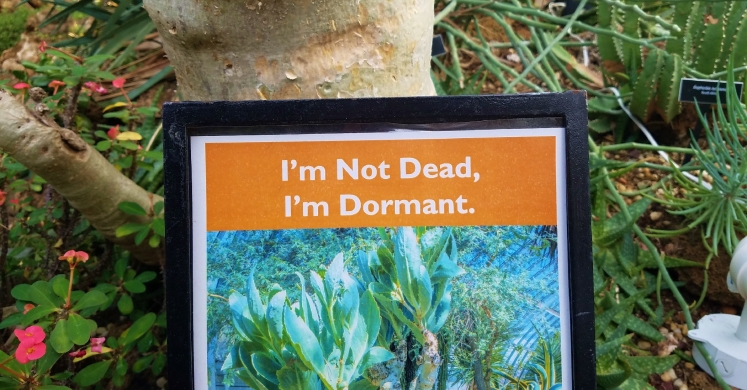Blog

#bioPGH Blog: Dormant in December
 A resource of Biophilia: Pittsburgh, #bioPGH is a weekly blog and social media series that aims to encourage both children and adults to reconnect with nature and enjoy what each of our distinctive seasons has to offer.
A resource of Biophilia: Pittsburgh, #bioPGH is a weekly blog and social media series that aims to encourage both children and adults to reconnect with nature and enjoy what each of our distinctive seasons has to offer.
Have you ever wondered how plants handle extreme conditions like drought and intense cold? We’ve chatted together before about how trees survive winter, but another important botanical trick for unfavorable conditions is to halt new growth. This prevents damage to vulnerable new tissue, especially in roots and shoots, and avoids depleting precious resources. In other words, plants go dormant!
As a broad summary, dormancy halts plant growth through a complicated process of chemical signaling among the plant’s cells. Plant hormones monitor and regulate the growth and extension of roots and shoots, the development of buds, and the growth of wood on trees. With the approach of winter in temperate climates, or the dry season in tropical climates, those hormones will suppress mechanisms that allow plant cells to divide. It’s almost as though the plant is frozen in time. When conditions are again favorable or when some internal requirement for the plant is met, growth can resume.
Technically, though, there are three different categories of dormancy. They can be fluid—one type of dormancy can become another, depending on environmental conditions—but the molecular and cellular processes for each category are different. Plants are fascinatingly complex!
Ecodormancy
This occurs when plants stop their growth because of an environmental cue, like cold weather or drought conditions. As soon as favorable conditions return, the plant can resume growth. This is the common seasonal slow-down in the winter that we in temperate areas like here in Pittsburgh. Plants won’t waste energy on producing new root extensions or shoots at the risk of losing to the new growth to freezing or desiccation (water loss).
Endodormancy
“Endodormancy” refers to plants’ halting growth because of some sort of internal signal (the prefix endo means within or containing). It is the plant’s physiological “decision” to stay dormant. Unlike ecodormancy, a change in environmental conditions such as warmer weather will not affect whether or not the plant remains endodormant. If you raise fruit trees, you are likely familiar with endodormancy—this is the “chilling time” that many trees need in order to flower properly. Many trees, shrubs, and other perennials require a chilling period of temperatures between 32 and 50 degrees Fahrenheit or the plants simply won’t produce flowers and, by extension, fruit. During that cold period, the plant sends chemical signals to buds to halt cell division (new growth). Once the chilling requirement is met, the plant stops sending the signal to halt growth, and the buds will continue developing into leaves or flowers. However, even if the plant is exposed to perfect growing conditions, if the chilling requirement has not been met, the plant will not take advantage of the favorable conditions.
Paradormancy
In a way, we can think of paradormancy as “localized” dormancy—for example, only buds going dormant—in response to a chemical signal like a plant hormone acting on a targeted tissue. As soon as the plant stops producing that signal, growth can continue. Granted, the process of how the plant hormone halts growth has not been completely untangled, but the process seems to involve activating a gene that stops cell growth in the target tissue (like buds).
Overall, plants’ ability to go dormant is a vital adaptation for survival. It’s an amazing feat, and though we may barely notice it, the inner cellular processes of plants are hard at work to ensure the survival of each mighty oak or small strawberry bush. Nature truly is wondrous.
Connecting to the Outdoors Tip: If you have ever looked at tree rings, you’ve seen that plant’s history of going dormant. During favorable conditions, every ring tells the story of a plant going dormant at the end of a growing season. This is also is why it becomes difficult to exactly age a tree—a ring forms every time a tree goes dormant, which can include both seasons of drought or some other intense stressor, meaning trees can lay down more than one ring in a year. The next time you see a cut log, try to take notice of when you see two rings exceptionally close together or perhaps even far apart. This is evidence of variation between growing years!
Continue the Conversation: Share your nature discoveries with our community by posting to Twitter and Instagram with hashtag #bioPGH, and R.S.V.P. to attend our next Biophilia: Pittsburgh meeting.
Resources
Campbell 2006: Dormancy and the Cell Cycle
MSU Extension: Winter dormancy and chilling in woody plants
Rathgeber 2016: Biological Basis of Tree-Ring Formation—A Crash Course
University of Missouri: Chilling Requirement for Fruit and Nut Trees
Header image: Vaidor Otsar, CC-BY-3.0

